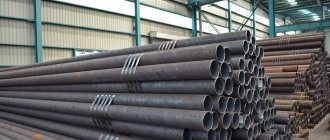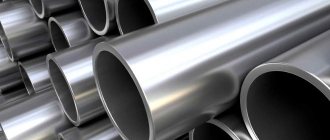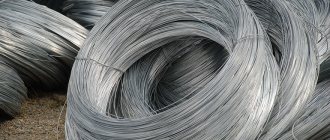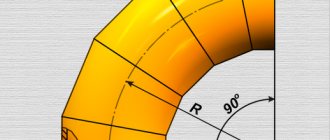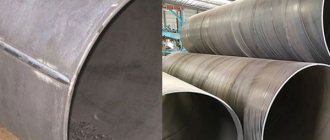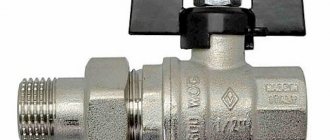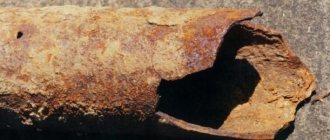Seamless pipes have become more widespread in various spheres of human activity only because there are no connecting joints in its design, hence, in principle, the name. It is several times more difficult to produce such a pipe, the costs are high, and therefore the production cost is considerable. But it’s worth it, because seamless pipes can withstand enormous loads, and therefore are used in such sectors of the national economy as mechanical engineering, oil and gas industry, aircraft construction and machine tool manufacturing, i.e. where materials are subject to fairly stringent requirements.
Seamless pipes are manufactured using a very interesting technology. To do this, a steel blank is taken, in which a through hole is made, after which it is rolled on special equipment, making it thinner and longer. The principle is not very complicated, but it is just apparent simplicity. By the way, there is another technology that differs from the first only in that the workpiece is cast in a special mold. A rod is installed in this form, with the help of which a through hole is formed. Such pipes are often called cast pipes.
Seamless pipe production
The creation technology is distinguished by a complex production process. Therefore, the product has a high cost. For this purpose, a cylindrical blank based on a monolithic material is used.
Types of production:
- Hot rolling on special equipment.
- Cold deformation method.
Either option simplifies welding, riveting or cutting.
Manufacturing method and production technology
For the production of seamless pipes, steel cylindrical blanks are taken. 2 manufacturing technologies are used:
- hot rolling;
- cold deformation.
Seamless cold-formed pipes are stronger than hot-rolled products. They have precise geometry and a smooth outer surface.
Hot rolled
The production process and characteristics of rolled products are regulated by GOST 8732-78.
The hot rolling method requires large financial costs, which makes hot-rolled seamless pipes more expensive. I’ll break down the technical process step by step:
- Preparation of blanks. Hollow blanks with a pre-selected cross-section and length are taken. The material is heated to a temperature of 1180-1200°C.
- Formation of the sleeve. A special high-power drill is used, which drills a hole with specified dimensions in the workpiece. After processing, the workpiece takes on the shape of a pipe, but it is not yet a finished product.
- Rolling. This stage includes several works. The sleeve is placed in special rolling machines consisting of several rollers. The workpiece placed between two rollers is pulled in one direction. At the end, a special limiting element is installed that controls the diameter of the future product.
The hot rolling process is repeated several times to achieve the desired result. Throughout the entire process, technical and safety regulations are observed.
The production of seamless pipes using the hot rolling method is shown in more detail in the video:
This will help to understand this issue more deeply (it personally helped me).
Cold-worked
Cold forming technology is regulated by GOST 8734-75.
These seamless pipes have high strength and a perfectly smooth surface, which is required when laying communication systems.
Before cold rolling, the workpiece undergoes preparatory cleaning using chemical compounds and pickling. Sometimes treatment with phosphates or copper is required. This increases the durability of the final result. Finished products are resistant to deformation.
After processing, the workpiece is formed into a round cross-section using rollers. If the rotation of the rollers changes, the gauge of the steel pipe will also change. When a round gauge with a large diameter is made, additional compression is carried out.
If it is necessary to reduce the cross-section of the pipe, the technology is repeated. The final stage is pickling and washing the product.
Hot Rolled Seamless Pipe
It is allowed to use 3 types of steel: alloyed and low-alloyed, carbon variations of the material.
Technology Features:
- A monolithic blank with a cylindrical shape is used. It is heated until the metal begins to crystallize. This requires at least 60 degrees. Plasticity appears for subsequent work;
- Using a piercing machine, a hollow blank in the form of a cylinder is created;
- Thanks to rolling, the required round shape with the intended dimensions is created;
- The workpiece is cooled in water;
- Calibration is performed using the rolling method;
- The pipe is cut to comfortable sizes. This is necessary for transportation and simplified installation.
Hot and cold forming
How are metal pipes made using the hot rolling technique? The technological process involves certain financial costs, for this reason the cost of these pipes ultimately turns out to be very impressive. The first stages involve performing preparatory work.
A workpiece is an element with a cavity of standard length and cross-section. A special grade of steel is used as a material for manufacturing. The hot deformation process has the following features: Before rolling, the workpiece is heated to a temperature that does not reach the start of the metal crystallization process with a permissible excess of 50-60 degrees. The workpiece becomes more plastic, but still retains its shape and does not melt; At the next stage, the formation of a sleeve is made using a special drilling machine capable of drilling a hole of the required diameter and depth in the workpiece.
A piercing press allows you to obtain a finished hollow cylinder from a pre-heated metal billet. However, this product only resembles a pipe in visual characteristics; During the rolling process, the sleeve is placed on a special machine equipped with several rollers. The sleeve installed between the rollers is gradually stretched in several directions; The required shape of the product is achieved after rolling, the dimensions of the pipe are adjusted during hot deformation. The diameter of the manufactured pipe is controlled using a limiting element; When immersed in water, the hot steel pipe is cooled, then final calibration is performed through several rollers. Some procedures from the above sequence can be performed several times to obtain the product of the required shape. At the final stage of the pipe processing process are cut into products of the required length. Cold forming technology involves two main distinctive features: The cooling procedure is performed after the workpiece leaves the piercing machine. Preliminary calibration of the pipe should be performed only in a cold state. When finishing rolling is performed, the sleeve is fired, heated to a temperature at which the process of recrestallization of the metal begins.
Pros and cons of seamless pipe
It's difficult to find significant flaws. The consumer notes the high cost. But most people care about technological features - is the absence of a seam good or bad?
This is what is considered the main advantage. The seamless pipe is characterized by increased strength and almost perfect tightness along its entire length.
Other benefits:
- Relatively small mass;
- Increased wear resistance.
Thanks to this, the product is used in various fields and even in the aircraft industry.
Construction area of application of seamless pipe
The next huge area of using seamless pipes is construction. This type of rolled metal is actively used in the construction of various buildings and structures, and other objects. That is, wherever the construction of metal structures is required. Moreover, if seamless pipes with a round cross-section are used for pipelines, then in construction it is a little different. In addition to pipes with a classic round cross-section, profile seamless pipes are actively used. The use of welded structures made of pipes with square and rectangular profiles is especially important. It is pointless to list all building structures where seamless pipes can potentially be used. Everything is so variable, from the structural elements of buildings to the enclosing structures. That is, all the same factors as in the case of mechanical engineering. We are talking about high temperatures, high pressure, resistance to loads, and reduction in weight of the structure.
But there is one additional factor. This factor is called decorative properties. The pipe does not have a seam, which means it looks more attractive than a welded one. They take advantage of this by actively using seamless stainless steel pipes in the design of premises and the creation of small architectural forms. However, seamless pipes made of carbon steel grades with a special coating, for example, chrome-plated, are also used.
And they did not note another important area - the arrangement of engineering systems for various functional purposes. For example, seamless pipes are actively used in the construction of wells, as casing. This is discussed in more detail in the article “Seamless pipe for a well - relevance of use and selection rules.” And in addition to this, we also note gutters, storm drains, and drainage systems. There are other designs where the use of seamless pipes is relevant.
Scope of application of seamless pipes
Thanks to their perfect characteristics, seamless pipes stand out among rolled metal products.
Where used:
- Crude oil production;
- Mechanical engineering;
- Chemical industry;
- Installation of housing and communal services communications;
To facilitate and ensure reliability and safety of various construction works, but a high level of tensile strength and lightweight weight ensured demand in shipbuilding.
Scope of application of seamless pipe - pipeline construction
Seamless pipe refers to rolled pipe. Therefore, it is natural that the main purpose is the arrangement of various pipelines. Moreover, the production technology allows us to produce pipes that can withstand such characteristics of the working environment as:
- high pressure;
- elevated temperature;
- chemical composition.
Steam and certain liquids can be transported under very high pressure. Therefore, welded pipes are subject to deformation due to lower structural strength. Initially, the steam has a very high temperature, and sometimes the liquids move very hot. Thermal expansion occurs, which can lead to deformation of the structure. Seamless pipes for special purposes are available that can cope with this.
As for the chemical composition of the working environment, a number of substances can negatively affect the strength of the pipe. Sometimes some elements enter into a chemical reaction with the metal. This changes the composition of the fluid being moved.
Add to this the ability of seamless pipes to withstand various negative environmental factors. Plus a wide range of products, ranging from seamless tubes to main seamless pipes of huge diameters.
Based on this, the main directions of use are determined. Now we are talking about pipelines.
Standards and available range
In order to streamline and ensure product quality, it was decided to introduce GOSTs based on several criteria:
- Increased or standard manufacturing accuracy is provided;
- There are thick, thick-walled, thin-walled or very thin types;
- There are either measured or unmeasured seamless pipes in length.
Based on state standards, seamless seamless pipes are classified into two main classes. These are GOST 8732-78 and 8734-75. Other assortments are used much less frequently. But sometimes GOST 8731 74 is found.
Classification
Seamless steel pipes are divided into classifications according to:
- production method;
- temperature parameters;
- cutting method, etc.
According to the type of section, the models are divided into:
- round;
- oval;
- square;
- rectangular;
- trapezoidal, etc.
Classification by length includes products:
- measured;
- unmeasured;
- multiples of any measured length.
The most common classification of metal products is those produced by cold or hot rolling.
The standard length of cold worked pipes is 4.5-9 m. The steel thickness of the products varies from 8 mm.
Hot-rolled structures are produced with a cross-section of 25-700 mm, with a steel thickness of 2.5-75 mm depending on the functional purpose. Seamless, seamless pipes are created from cast billets that provide high strength.
Pipe GOST 8732-78
It is used on the basis of hot rolling or deformation process. The diameter of this type of steel pipe is offered from 2 to 55 cm. The walls can have a maximum thickness of up to 75 mm, but not less than 25 mm. A maximum length of 12.5 meters is allowed.
Other features:
- The main difference between this type of seamless pipe is its resistance to wear;
- Withstands significant physical pressure.
Due to their reliability and durability, they are used for laying gas pipelines or pipelines for transporting various liquids, including oil and gas, without additional pipe reinforcement.
Advantages
Naturally, the main distinguishing feature and advantage of solid pipes is the absence of any seams. This feature reduces the likelihood of damage and increases resistance to mechanical stress. Hot-rolled pipes, made from thick metal sheets, are highly resistant to corrosion. However, such products are not particularly flexible in the process of repairing or installing any structures. This is of great importance because the installation will not bring the desired result.
Hot-rolled pipes are considered literally ideal materials for the construction of various communications. When using different types of connections, all kinds of structures and design structures can be created. This requires strict adherence to existing connection technologies and installation rules. Hot-rolled seamless products, due to their high strength characteristics, are excellent for equipping various types of systems with high internal pressure.
Pipe GOST 8734 75
This state standard is used to classify pipes created on the basis of cold deformation. It stands out for its ability to produce small diameters in the region of 5 - 250 mm and reduced wall thickness of 0.3 - 24 mm.
Important: Despite the significantly reduced dimensions, various tests have proven that the strength and wear resistance characteristics are no worse than those of hot-rolled products.
In addition, 8734-75 is distinguished by its increased ductility without loss of strength or resistance to bending moment.
About the benefits of the arms race
Let's start with the fact that the very birth of the technology for making seamless pipes owes much to the arms race of the 19th century, when, after the Crimean and Franco-Prussian wars, the great powers became concerned with improving artillery systems.
Guns were required to become increasingly powerful and long-range, with an increasingly longer barrel length - but the casting and drilling technologies available at that time reached the limit of their capabilities in this regard back in the 70s of the 19th century. Barrels longer than 2 meters made using such technologies lost so much accuracy in shooting that it made no sense to produce them.
But then came the discovery of the Mannesmann brothers, who in 1886 in Germany at their metallurgical plant discovered an effect that formed the basis for the production of hot-rolled seamless pipes.
It turned out that when a round metal workpiece, moving along its axis, is processed by conical rolls rotating in one direction in a vertical plane at an angle of 4–12 degrees, a small hole is formed in its axial part. Which can then be increased by rolling to the desired diameter.
At the 1889 World's Fair, seamless pipes created a sensation - American inventor Thomas Edison even called the method of their manufacture "the most amazing discovery of the century."
Of course, the military really liked the new technology precisely as a way to manufacture gun barrels several meters long (with a corresponding increase in power and range) - and the artillery arms race entered a new stage.
However, there is a silver lining: seamless pipes have also begun to be used in civil industries. Very soon they provided large cities with reliable water supply systems, the chemical industry and shipbuilding (then still steam-powered) with reliable pipelines, and geologists with the ability to extract oil from depths of several hundred meters. Well, then - you know...
Pipe GOST 8731 74
This is a rare kind of quality standard. It was actively used, but is not popular now.
- In any case, all types of seamless pipes are considered to be of high quality only if they can withstand exposure to significant temperature or pressure.
- Therefore, the manufacturing method is considered secondary. The main thing is the acquired characteristics.
- In order for the product to turn out really good, it is best to rely on a rolling machine.
It is important to realize that different manufacturing methods affect not only the characteristics, but also the cost. The higher the quality of a seamless pipe, the more expensive it is valued.
Peculiarities
The one-piece type of product is considered resistant to environmental impacts due to its high reliability and elasticity. Steel—both hot-rolled and cold-rolled—is wear-resistant. Seamless products made from different types of steel can be amenable to different types of metalworking: riveting, cutting, welding.
Unique manufacturing methods make it possible to achieve high strength of products relative to atmospheric pressure, and also save material, time and money that will have to be spent on construction.
At all stages of product creation, it is subject to careful quality control. The manufacturer tests products according to general standards. They can be tested in different ways for flattening, bending, and impact strength. Also, special testing of the chemical components included in the steel must be carried out.
Seamless pipe installation
Much depends on the wall thickness of the seamless pipe. As a rule, welding is used for installation. But it is very important to trim the seams before starting the connection, since the ends of the pipe will gain improved adhesion.
Welding nuances:
- A gas welding machine is used to connect thin-walled seamless pipes. Thanks to this equipment, even a beginner can easily complete the job;
- Pipes with a wall thickness starting from 20 mm can only be welded with an electric device, since the gas version is not powerful enough.
Tip: It is advantageous to bend seamless pipe GOST 8732 78 with a mechanical pipe bender.
Now we understand what seamless pipe is used for, what types there are, and manufacturing technologies. And we looked at installation methods.
Production methods
The production of seamless pipes is carried out:
- by manual or hardware (stamping) forging;
- using rolling mills;
- drawing method;
- pressing on special devices.
The work is carried out mainly in workshops of factories equipped with special equipment for different types of rolling. Enterprises must be provided with appropriate certificates that confirm the right to manufacture pipeline products in accordance with GOST standards for hot-rolled and cold-produced products. Before being sent to customers, products are tested for defects and compliance with standard size.
Hot deformation
Hot-formed pipes are produced by heating to high temperatures. Production requires the availability of technological equipment and the organization of a multi-stage process. The cost of the products is high.
Before the rolling process, the workpieces are heated without exceeding the crystallization point of the metal raw material (permissible error - +60 ° C). Products must hold their shape and be flexible enough to work. The sleeve is formed using a special drilling technique with elements that allow you to create the required depth and diameter in the metal product.
On a pressing machine, a cylinder is formed from a heated billet, visually similar to a pipe. When rolling, the liner is placed on machine tools and passed through rollers of different diameters. Under the pressure of the elements, the workpiece is stretched in opposite directions.
The required diameter shape is given to the product by rolling, and the dimensions are adjusted during heat treatment. The uniform diameter parameter along the length of the product is controlled by restrictive parts of the equipment.
The hot workpiece is cooled by immersion in cold water and calibrated by passing several rollers. Some steps in the manufacturing process may be repeated to customize the metal product to specifications. Finally, the products are cut into elements of the required length.
Cold deformation
Cold-deformed pipes are produced from prepared elements in a cooled state after passing through a piercing machine. The preliminary calibration process is performed on cold metal.
After finishing rolling, the sleeve undergoes a firing process and is heated to the temperature at which the metal begins to recrystallize. Finished chilled products are cut into pipes of the required length.
Cold forming products are manufactured:
- with especially thin walls (less than 0.5 mm) with a diameter of 20 mm;
- with thin walls (1.5 mm) with a diameter of 20 mm;
- with thick walls (6-12.5 mm), etc.
External walls and street structures are decorated with cold-deformed products.
Photo of seamless pipes
Advantages of seamless tubes
Seamless pipes, in addition to the ability to withstand high pressure, have another significant advantage - plasticity. When bent even at large angles, seamless pipes straighten without problems without breaking the surface, while their welded counterparts under the same loads “burst” along the seam or “break” at the bend. That is why lighting poles along roads, posts for road signs, etc. – everything that can be exposed to forces that can “break” the pipe, according to existing standards, must be made from seamless products.
In addition, when seamless pipes still cannot withstand internal pressure, they do not “open up” along the seam, but receive local ruptures that are much smaller in area. This property of seamless steel pipes made it possible to lay high-pressure pipelines.
Characteristics of electric-welded pipe products according to GOST 10706-76
- Weight (1 m): no more than 500 kg.
- Outer diameter: from 530 to 1420 mm.
- Wall thickness: from 7 to 16 mm.
The weight of the pipe depends on its cross-section. The product has 1-2 welds. Dimensions and maximum deviations correspond to GOST 10704.
Conclusion
The most important differences are the manufacturing method and area of application. The difference between the seamless type and the electric welded type is that the second has a straight or spiral seam.
Electric welded products are inferior to seamless products due to the presence of a longitudinal seam along which leaks can occur. Such pipes must be installed with seams away from the walls, so that in the event of a leak, it is possible to weld the fistula. However, this depends on the level of production and the quality of the metal itself. There are increased requirements for metal quality for electric-welded products, and modern welding methods make it possible to increase the durability of products while maintaining versatility, so the risks are minimal. Also, one of the disadvantages is that bending electric-welded pipes is more difficult, the seams can crack and make the surface more vulnerable to corrosion.
The service life of a seamless product will be slightly longer, all other conditions being equal. But the production of electric welded pipes is cheaper and easier. The technology has fewer limitations, particularly in terms of size. The maximum size of a seamless product is smaller. One of the advantages of the electric welding method is that you don’t have to spend a lot of time on production. Installation of electric welded pipes does not cause additional difficulties.
The choice directly depends on the application of pipe products and operating conditions. A more economical option is suitable for most household needs - an electric-welded pipe with sufficient strength characteristics. The product must comply with GOST. If more severe conditions and aggressive environments with high pressure prevail, then a seamless option should be chosen.
